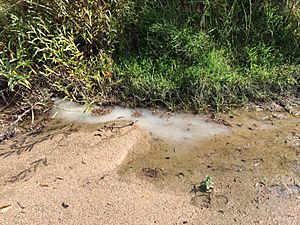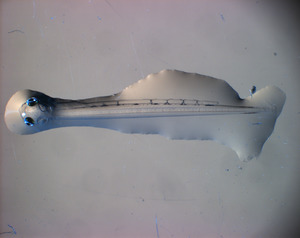Common galaxias facts for kids
The common galaxias (Galaxias maculatus), also known as inanga (its Māori name), is a very common fish found in the Southern Hemisphere. It belongs to the Galaxiidae family. This fish is slim and narrow, with a tail that splits into two parts (forked). It has a spotted pattern on its body. When fully grown, it is usually about 10 cm (4 in) long.
Common galaxias live in freshwater, but they lay their eggs near river mouths. The young fish then spend their first six months in the ocean. After this, they return to fresh water in large groups during spring. People call this fish by many names, including cowfish, jollytail, whitebait, and native trout.
Quick facts for kids Common galaxias |
|
|---|---|
 |
|
| Conservation status | |
| Scientific classification | |
| Genus: |
Galaxias
|
| Species: |
maculatus
|
| Synonyms | |
|
Galaxias usitatus McDowall, 1967 |
|
Contents
About the Common Galaxias
Common galaxias have shiny silver eyes, bellies, and gill covers. Some even have a shiny green stripe along their backs. This stripe can be seen as they swim. Their scientific name, maculatus, means "spotted." This refers to the dark, leopard-like spots on their olive-brown bodies. These spots can be very faint or quite clear.
Unlike most other galaxiids, common galaxias have slightly forked tails. Most others have square tails. Adult fish are usually 8 to 11 cm (3 to 4 in) long, with an average of 10 cm (4 in). The longest one ever found was 19 cm (7.5 in) long.
These fish often swim together in small groups called schools. They prefer slow-moving water. However, in faster streams, they might swim alone.
Where They Live
Common galaxias are one of the most widespread freshwater fish in the world. You can find them in places like Chile, Patagonia in Argentina, the Falkland Islands, and some Pacific Islands like New Caledonia. They also live in New Zealand and coastal rivers in southeastern Australia, Tasmania, and southwest Western Australia.
Adult common galaxias mostly live in still or slow-moving water. They are found in the lower parts of rivers and streams near the coast, or around the edges of lagoons. They can handle many different natural conditions. If there isn't enough oxygen in the water (due to things like too many nutrients, called eutrophication), they can jump out. They can then breathe a little through their skin as a last resort.
They need plants along the riverbanks to lay their eggs. They usually live in river systems that connect to the sea, because their young fish grow up in the ocean. They tend to stay in lower parts of streams. This is because, unlike other Galaxias species, they cannot climb over waterfalls.
Sometimes, common galaxias get stuck in lakes, like in five lakes in Northland, New Zealand. In these cases, they live and breed among large beds of reeds.
Life Cycle
Common galaxias are usually considered amphidromous. This means they reproduce in fresh water, but their young (larvae) grow up in the sea.
Reproduction
Adult fish usually become ready to reproduce when they are one year old. They start spawning (laying eggs) when the day length and temperature change. If they are not stuck in a lake, common galaxias mainly spawn in autumn. This happens during high tides in parts of rivers and streams that are affected by the tide. However, they can also spawn in winter and spring.
Female fish lay many eggs together among plants that are flooded by the tide. Then, male fish release their sperm into the water, and the eggs are fertilized outside the female's body. This type of spawning is called polygynandry. The eggs stay attached to the plants as the tide goes out. Some fish lay all their eggs at once and then die (this is called semelparity). Others lay eggs multiple times before they die (this is called iteroparity).
Egg Development
The eggs are about 1 mm (0.04 in) wide and develop in the plants for 2 to 4 weeks. The conditions around the plants, especially temperature and humidity, are very important for the eggs to grow well. Many eggs can die if they get too much sunlight. They can also be eaten by mice and spiders. Farm animals grazing or walking on the banks, or mowing plants in cities, can also harm the eggs. Flooding can also cause eggs to die. The next high tide then floods the eggs, which makes them hatch.
Ocean Life
After hatching, the young fish, called larvae, are about 7 mm (0.28 in) long. They are carried out to sea and spend 3 to 6 months there. Scientists don't know much about this part of their life. This is because the larvae are tiny, clear, and hard to find. Ocean currents are very important for moving them around. Temperature and how much food is available also affect how long they stay in the sea. This time in the ocean is very important. It allows young fish from different groups or rivers to mix and connect.
When the young fish, now called juveniles, are big enough (about 30 to 55 mm or 1.2 to 2.2 in long), they swim back into fresh water. They form large schools as they move through river mouths. Some of their life is spent in the lower parts of rivers. Here, they change their bodies (this is called metamorphosis) before living their adult lives in suitable freshwater places. Some fish return to the exact river they were born in, but most go to different rivers.
Freshwater Life
After changing their bodies, adult fish spend about 6 months in fresh water. During this time, they grow and get enough energy to start reproducing. Male fish usually become ready to reproduce earlier and are smaller than females.
Parasites
In New Zealand, a tiny flatworm called Deretrema philippae can live inside the common galaxias's intestine and possibly its gall bladder. In Argentina, another flatworm called Steganoderma szidati has been found in the intestines of these fish.
Fishing for Galaxias
Young common galaxias are caught as whitebait when they swim upstream. People value them as a special food. Because of this, there are rules and special fishing seasons to protect the adult fish. They are fished for money in New Zealand, Chile, and Argentina. However, the last commercial fishery in Australia (Tasmania) closed in the 1970s.
Some places allow fishing for adult common galaxias, but again, there are rules or licenses to protect the fish population. Other places ban it completely, unless the fisher is part of an indigenous group, like the Māori in New Zealand. For example, in Tasmania, you can only catch adult common galaxias with a pole no longer than 1 meter (3.3 ft).
Protecting the Species
Many galaxiid species are in danger because of human activities. These include intense farming and changes in how land is used. These activities have removed plants from riverbanks, which are needed for the fish to lay their eggs safely from the sun. Also, more nutrients from farming can get into streams, leading to too much plant growth (eutrophication). In New Zealand, the common galaxias's numbers are decreasing. This is mostly because they are losing their homes and their habitats are getting damaged.
Adult common galaxias eat insects, crustaceans, and molluscs. This is the same food that introduced trout eat. Trout not only compete for food but also eat the galaxias. In areas where trout have been introduced, common galaxias are rare. So, common galaxias are mostly found in parts of streams and rivers that trout don't like as much.
Restoration Efforts
In some parts of New Zealand, the places where this fish lays its eggs have been damaged. This is due to farming, city growth, and land use changes. When this happens, rivers become "sink populations." This means adult fish have no good places to lay their eggs, and most eggs die. Because these "sink rivers" don't produce eggs or young fish, there's a gap in the ocean during the time the young fish are supposed to be spreading out. Young fish from these "sink populations" cannot mix with others. However, these "sink populations" can receive young fish born in other rivers. But these new fish won't be able to reproduce successfully, and the "sink cycle" continues.
New ways to fix the egg-laying habitats along riverbanks include using straw bales. These bales can temporarily replace natural plants. Straw bales offer the same conditions and structure as real plants, helping the eggs develop well. This method makes sure that eggs and young fish are produced, and that each river becomes a source of young fish. Keeping farm animals away and fencing off plants along the banks also helps suitable plants grow back. Fixing the egg-laying habitats helps keep young fish from different rivers connected as they spread out in the ocean.
Images for kids
See also
 In Spanish: Puyén chico para niños
In Spanish: Puyén chico para niños






